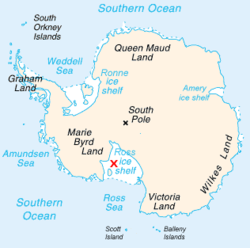Ross Ice Shelf 06/05/2019 – Posted in: Daily News
ROSS ICE SHELF
For: Mains
Topics Covered: Ross Ice Shelf, Ice Shelves, Findings of study, Why melting rapidly
News Flash
Antarctica’s biggest ice shelf may be more vulnerable to climate change than previously thought.
Findings
- A new study shows that a key section of the France-size hunk of ice (Ross Ice Shelf) is melting much faster than the rest.
- Melting ice in Antartica has focused on the rapidly melting western shore, where there is enough ice to raise worldwide sea levels by up to 4.3 feet.
- But the massive Ross Ice Shelf, potentially leading to a slower sea level rise of up to 38 feet as glaciers that were once held back by the shelf slide more quickly into the ocean.
- Satellite measurements over the past 26 years have shown these ice shelves sinking, indicating that some are thinning by up to 7 meters (about 23 feet) per year. As a result, the glaciers they support — which contain enough ice to raise global sea levels by over four feet — are flowing rapidly into the sea.
Ross Ice Shelf
The Ross Ice Shelf is the largest ice shelf in the world. Located on the side of Antarctica closest to New Zealand, it spans an area about the size of Spain and has an average thickness of roughly 1,300 feet. It is one of many ice shelves that extend oceanward from the edge of Antarctica with about 90 percent of their bulk submerged.
Melting of these ice shelves has no direct effect on global sea levels, since the ice is already at equilibrium with the surrounding water. But the ice shelves greatly slow the flow of glaciers on the continent that would otherwise slide faster into the ocean, causing water levels to rise.
Ice shelves
Ice shelves are thick, floating masses of Antarctic ice that form as nearby glaciers flow toward the sea.
Why Ross Shelf is melting rapidly
According to researchers, the strong offshore winds are blowing sea ice away from the leading edge of the ice shelf, exposing regions of the ocean to the sun’s warmth that previously had been covered by ice. The water’s warmth hastens the melting of the ice.
Warmer temperatures could cause the sea ice around ice shelves to thin, making it easier for wind to blow patches away and expose ocean water to sunlight.
Researchers also identified an especially vulnerable section where the melt rate is 10 times higher than the rest of the ice shelf.
Ice loss in the Antartica
- Hydrofracture is one of two mechanisms thought to account for most of the ice loss in the Antarctic.
- The other mechanism happens when deep, warm ocean currents flow far under an ice shelf, eating away at the “grounding line” where it connects to the land.
- Another possible reason with the Ross’s problem is seasonal masses of warm water near the ocean surface in front of the ice shelf.
- In winter, a crust of sea ice — far thinner than the actual ice shelf — covers the ocean in front of the shelf. But in summer, that sea ice melts, and the dark water absorbs solar energy and warms the water beneath. This warm surface water then erodes the northwestern corner of the Ross Ice Shelf, eating away at ice under the lip and causing small icebergs to crumble from its edge.
Source: NBC News
You can follow us on LinkedIn and for more updates related to UPSC IAS Preparation, Like our Facebook Page and subscribe our Diligent IAS Youtube Channel
Also Read Related Daily News

